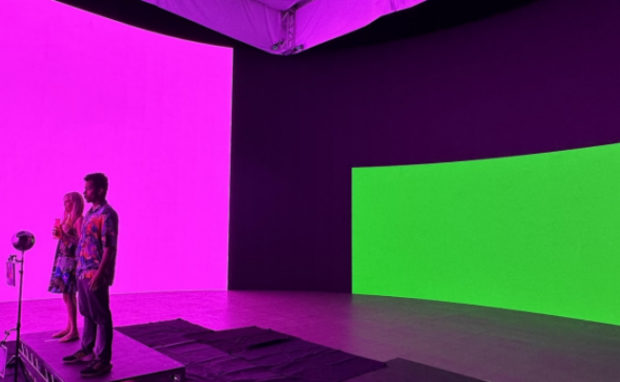Netflix improves green-screen filmmaking with AI
Video streaming app Netflix released a research paper that enhances the conventional green screen filmmaking technique with artificial intelligence. It shines a harsh magenta light on actors to highly contrast them with the green background. Then, an AI model compares their normal photos with magenta-tinted footage to restore the actors’ color quality.
Making movies isn’t as simple as shooting an Instagram Story or a TikTok clip. Filmmakers use advanced techniques to create stories on the silver screen. Nowadays, many films rely on green screens to reduce prop costs and project fantastical backgrounds.
The industry continues to improve with the latest AI technologies. Soon, the next movie you watch may use this technique, or you may shoot your upcoming project with it. This article will discuss how Netflix’s latest green screen AI method works. Also, I will compare it with the conventional method.
How does Netflix’s green screen AI work?
Netflix’s latest filmmaking research is called “Magenta Green Screen.” As the name suggests, it bathes actors and everything else in the foreground in a red-and-blue light.
The latter tints the foreground magenta, highly contrasting it with the leaf-colored background. TechCrunch explains that using only one color makes it harder for a computer to distinguish them.
Of course, actors look purple in shots. A “naive” linear approach can color-correct them, but the results often look yellowish and washed out. That is why Netflix created an artificial intelligence model to color-correct magenta-tinted artists. Here’s a simplified version of how it works:
- Filmmakers take normal photographs of their actors.
- Next, they shoot scenes with a violet-colored foreground.
- Then, the AI program refers to the original shots to color actors and other foreground elements properly.
You may also like: Hacker finds “Elon Mode” for Tesla Cars
Netflix senior researcher Dmitry Smirnov published a paper about his new video compositing method: “Magenta Green Screen: Spectrally Multiplexed Alpha Matting with Deep Colorization.” His technique allegedly requires no special camera equipment or manual color adjustments.
“Our technique appears to outperform the matting that which can be obtained with either traditional chromakey green screen or time-multiplexed techniques,” Smirnov added.
Also, Paul Debevec, another research team member, explained the significance of their project. “Computers already have provided such powerful tools to make a lot of stuff easier. The talented artists that we have can focus on the artistry, actually making things look better.”
What is the green screen method?

Photo Credit: finance.yahoo.com
Understanding Netflix’s latest technology requires a basic understanding of green-screen filmmaking. Let’s use the Marvel superhero films as examples.
These movies feature the world’s favorite caped wonders in fantastical settings. For example, a “Spiderman: Homecoming” scene featured Tom Holland’s web crawler fending off Benedict Cumberbatch’s Dr. Strange in another dimension.
It shows them jumping around in a location unlike anywhere on Earth. Past filmmakers used rudimentary props to simulate these fictional environments.
Nowadays, most movies use compositing or placing actors before a digitally-generated background. As a result, studios save time and money creating specialized effects and props.
More importantly, it enables modern, high-quality science fiction movies. The simplest compositing method was chroma keying. It involves recording actors against a brightly-colored background that a computer may easily detect.
The computer identifies foreground actors as a matted channel and the background as an alpha channel. Green screens highly contrast the channels, so the computer can only project a scene on the alpha.
You may also like: How to cancel Netflix subscriptions
It is a convenient and cost-effective method that many YouTubers use nowadays. However, it has numerous drawbacks, such as difficulty showing fine details like hair.
These could be too thin to contrast with the green screen, so they usually blend with the background. Also, actors can’t have colors that match the green screen.
For example, you probably can’t shoot a Green Lantern movie with this method. Otherwise, his costume would blend with the background, and he will like a floating head in the video.
Conclusion
Video streaming platform Netflix created a revolutionary green screen compositing method that involves shining red and blue light on actors. Then, it uses a proprietary AI model to color-correct shots.
It enables the conventional green screen method to capture fine details like hair accurately. More importantly, its researchers say the technique requires no specialized equipment.
Perhaps aspiring filmmakers worldwide could use this method to produce better motion pictures soon. Learn more about the latest innovations at Inquirer Tech.